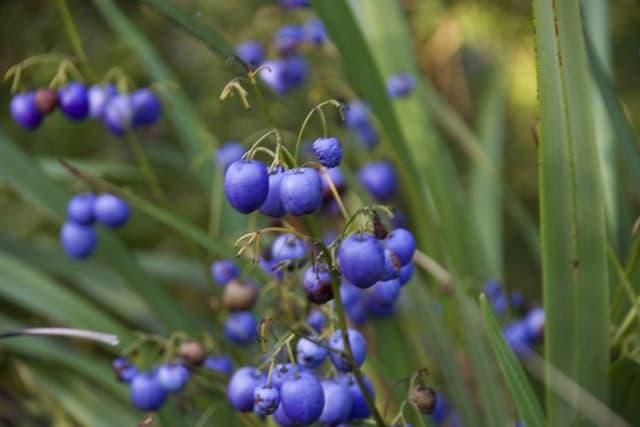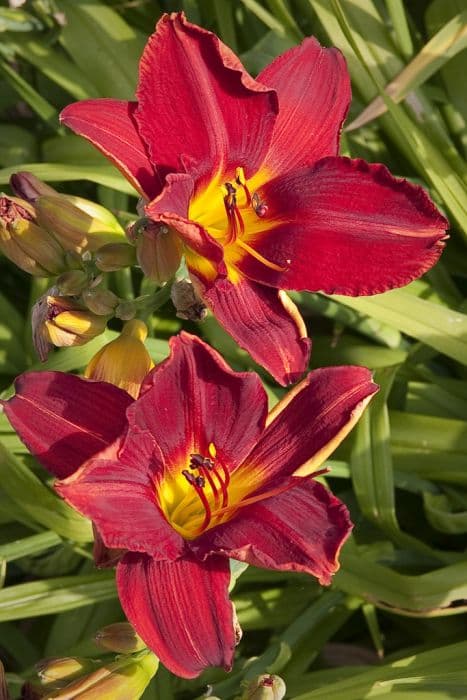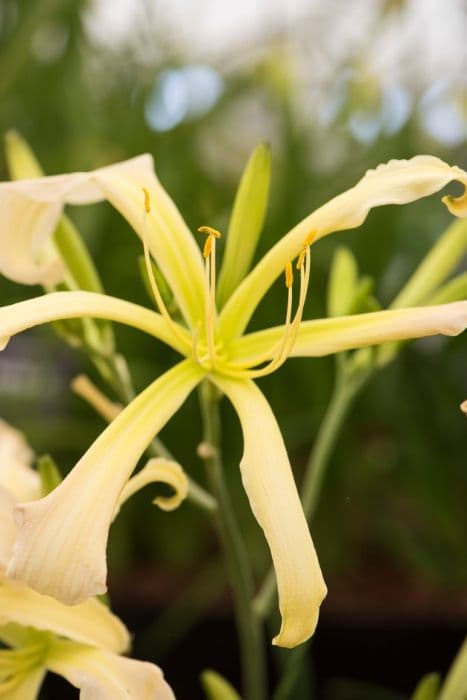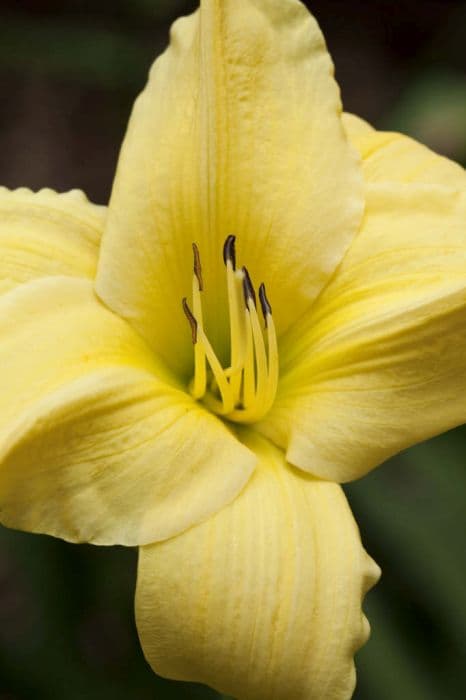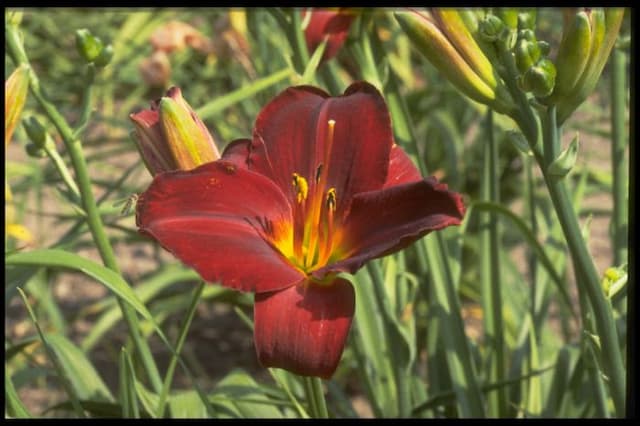Daylily Hemerocallis 'Black Magic'

ABOUT
The Hemerocallis 'Black Magic', commonly known as the Daylily, is a captivating plant with a distinctive and enchanting aesthetic. The Daylily is particularly noted for its sumptuous, dark flowers that exude a mysterious charm. These blooms are a deep, saturated color, often described as velvety maroon-black, and they typically feature a striking contrast with a vibrant yellow or green throat at the center, which adds a compelling focal point to each flower. The flowers themselves are trumpet-shaped and gracefully arching, embodying an elegant form that can add a dramatic touch to any garden. Each individual blossom is comprised of six petal-like segments, with the outer three being sepals and the inner three being true petals. Together, they create a harmonious and symmetrical appearance. The texture of the petals is soft and they may exhibit a subtle sheen or gloss, which further enhances their luxurious dark hue. The Daylily has long, slender, and arching leaves that emerge from the base of the plant in a clump. These leaves are strap-like, providing a lush, grassy backdrop that contrasts beautifully with the rich tones of the flowers. The foliage is bright green, adding a fresh vibrancy and serving as a perfect complement to the dramatic flowers. As a perennial, this Daylily tends to bloom in mid to late season, and while each flower only lasts a single day, the plant as a whole produces a succession of flowers that can keep the display going over an extended period. Due to these daily blooms, the Daylily ensures an ever-evolving and diverse floral show throughout its blooming season. With care, the Hemerocallis 'Black Magic' can become a standout specimen with its exotic and striking blooms in a range of garden settings.
About this plant
 Names
NamesFamily
Hemerocallidaceae
Synonyms
Daylily, Common Daylily, Tawny Daylily
Common names
Hemerocallis 'Black Magic'
 Toxicity
ToxicityTo humans
Daylilies, including the variety 'Black Magic', are not considered toxic to humans. In fact, some parts of daylilies are edible and have been used in culinary applications in different cultures. However, it is always important to be cautious and ensure correct identification, as there are many plants with "lily" in the name that are highly toxic. If someone were to consume a true toxic lily by mistake, they could experience symptoms such as abdominal pain, vomiting, and diarrhea.
To pets
Daylilies, like the 'Black Magic' variety, are highly toxic to cats. If a cat ingests any part of a daylily, it can cause acute kidney failure. Symptoms of daylily poisoning in cats include vomiting, lethargy, inappetence, and possibly increased or decreased urination. Without prompt treatment, ingestion can lead to severe kidney damage and can be fatal. It's important for cat owners to keep daylilies out of reach or avoid having them if they have cats.
 Characteristics
CharacteristicsLife cycle
Perennials
Foliage type
Deciduous
Color of leaves
Green
Flower color
Red
Height
2 feet (60 cm)
Spread
2 feet (60 cm)
Plant type
Herb
Hardiness zones
3-9
Native area
Asia
Benefits
 General Benefits
General Benefits- Ornamental Appeal: The Hemerocallis 'Black Magic', commonly known as Daylily, has dark dramatic flowers that provide visual interest and enhance garden aesthetics.
- Ease of Care: Daylilies are known for their hardiness and require minimal maintenance, making them ideal for both beginner and experienced gardeners.
- Durability: They are able to withstand a variety of climatic conditions, from extreme heat to cold, and are generally pest-resistant.
- Long Blooming: Daylilies have a long blooming season, with flowers that each last only a day but with many buds that open in succession over several weeks.
- Versatile Landscaping: Their strappy foliage and vibrant flowers lend themselves well to a variety of garden designs, including borders, beds, and containers.
- Drought Tolerance: Once established, Daylilies can tolerate periods of drought, making them suitable for xeriscaping and water-wise gardens.
- Propagation: They can be easily propagated by dividing the root clumps, allowing gardeners to expand their plantings or share with friends.
- Attracts Wildlife: The flowers attract pollinators such as bees and butterflies, promoting biodiversity in the garden.
- Soil Improvement: As perennial plants, Daylilies can help with soil erosion control and improve soil structure over time.
 Medical Properties
Medical PropertiesThis plant is not used for medical purposes.
 Air-purifying Qualities
Air-purifying QualitiesThis plant is not specifically known for air purifying qualities.
 Other Uses
Other Uses- Hemerocallis 'Black Magic', commonly known as the Daylily, can be used in flower arranging and floral crafts, adding a dramatic, deep color accent to bouquets and centerpieces.
- The Daylily's fibrous roots can be used in erosion control plantings, helping to stabilize soil on slopes and in areas prone to erosion.
- Its vibrant blooms can serve as a natural dye source for fabrics, providing a range of colors from soft yellow to deep orange, depending on the part of the flower used and the mordant.
- Daylilies are often planted in traffic medians and roadside planting strips where they can tolerate the heat and occasional neglect while still providing a splash of color.
- The flowers of the Daylily can be frozen in ice cubes to create an attractive and edible addition to summer drinks and punch bowls.
- These plants can be used as indicators of the time of day, as each flower typically lasts only one day, with new blooms opening in the morning and closing in the evening.
- The spent blooms of Daylilies can be collected and used as a natural mulch or compost material, returning nutrients to the soil as they decompose.
- Daylilies can be used in companion planting to help deter certain pests from more sensitive plants in mixed borders or vegetable gardens.
- With their dense growth habit, Daylilies can be planted to fill in bare spots in the garden, reducing weed growth through competition for space and resources.
- The Daylily's thick roots can be used to break up heavy, compacted soils over time, improving soil structure and drainage with their natural growth processes.
Interesting Facts
 Feng Shui
Feng ShuiThe daylily, specifically the 'Black Magic' variety, is not typically associated with Feng Shui practice.
 Zodiac Sign Compitability
Zodiac Sign CompitabilityThe daylily is not used in astrology practice.
 Plant Symbolism
Plant Symbolism- Resilience: The daylily, which is the common name for Hemerocallis 'Black Magic', symbolizes resilience because it can thrive in a variety of conditions and returns year after year.
- Motherhood: In Chinese culture, daylilies are a symbol of motherhood due to their nurturing and caring nature as seen in their flourishing blooms.
- Transience: Daylilies often represent the fleeting nature of life, as their individual flowers typically bloom for just one day.
- Beauty: With its elegant form and striking color, the 'Black Magic' cultivar of the daylily symbolizes beauty and refined taste.
- Forgetfulness: The daylily can also symbolize a desire to forget worries or troubles due to the ephemeral nature of its flowers.
 Water
WaterDaylilies, like the Hemerocallis 'Black Magic', prefer consistent moisture, so water them deeply once a week providing about one inch of water which is approximately 0.623 gallons per square yard, if rainfall is insufficient. During hot, dry spells, you may need to water twice a week. It's best to water in the morning to allow the foliage to dry during the day and reduce the risk of fungal diseases. Avoid overhead watering to minimize water on the leaves and flowers. Make sure the soil is well-draining to prevent root rot.
 Light
LightDaylilies, including the 'Black Magic' variety, thrive in full sun, which means they require at least six to eight hours of direct sunlight per day. An ideal location is a spot that receives morning light and some shade during the hottest part of the afternoon, although these hardy plants can handle full sun all day. Daylilies can tolerate partial shade but will produce fewer flowers.
 Temperature
TemperatureDaylilies like the 'Black Magic' are hardy plants that can survive in a wide range of temperatures, usually from -20°F to 90°F, but they perform best when the temperature ranges between 60°F and 80°F. Avoid planting in areas where the temperature may drop below -20°F without a protective layer of mulch.
 Pruning
PruningPrune daylilies like 'Black Magic' by removing spent flower stalks and dead leaves throughout the growing season to encourage rebloom and maintain plant health. After the first heavy frost in the fall, cut back the foliage to about 2 to 3 inches above the ground. Pruning is best done on a dry day to prevent disease spread.
 Cleaning
CleaningAs needed
 Soil
SoilDaylilies thrive in well-draining, moderately fertile soil with a pH between 6.0 to 6.5. A mix of garden soil, compost, and a bit of sand is ideal to provide the necessary nutrients and drainage.
 Repotting
RepottingDaylilies, being perennials, do not typically require frequent repotting. They can be divided every 3 to 5 years to manage their size and invigorate growth.
 Humidity & Misting
Humidity & MistingDaylilies are tolerant of a wide range of humidity levels and do not require any specific humidity conditions. They grow well in the ambient outdoor humidity.
 Suitable locations
Suitable locationsIndoor
Place daylilies in a well-lit spot and ensure soil drainage.
Outdoor
Plant in full sun to partial shade with good soil drainage.
Hardiness zone
3-9 USDA
 Life cycle
Life cycleThe daylily 'Black Magic' begins its life cycle when a seed germinates in warm, moist soil, typically in the spring. After germination, the seedling emerges and grows into a juvenile plant, developing a clump of strap-like foliage while establishing a root system. As the plant matures, it enters a vegetative stage where it continues to grow and multiply, producing more foliage and expanding its root system. Upon reaching maturity, usually within a year or two, the daylily begins its annual reproductive phase, producing tall scapes topped with the characteristic dark maroon to almost black blooms during early to mid-summer. After flowering, the blooms last just one day each, hence the name "daylily," and are followed by the development of seed pods if pollination has occurred. The plant then enters a period of senescence towards late summer or fall, where foliage may die back, especially in colder climates, before the cycle restarts with the return of warm weather in the spring.
 Propogation
PropogationPropogation time
Spring-Early Summer
Propogation: The Hemerocallis 'Black Magic', commonly known as the Daylily 'Black Magic', is most effectively propagated through division, which is best done in either spring or early fall. To propagate by division, carefully dig up the clump of daylilies, making sure to keep a good amount of soil around the roots. Gently separate the clump into smaller sections, each with at least a few fans of leaves and a portion of the root system intact. Replant the divisions at the same depth they were previously growing, ensuring that the crowns are approximately one inch below the surface of the soil. Water the new plantings thoroughly to settle the soil and help reduce transplant shock. This method enables the gardener to rapidly increase their stock of Daylilies 'Black Magic' while maintaining the genetic integrity of the plant.
